Let's celebrate Beauty!
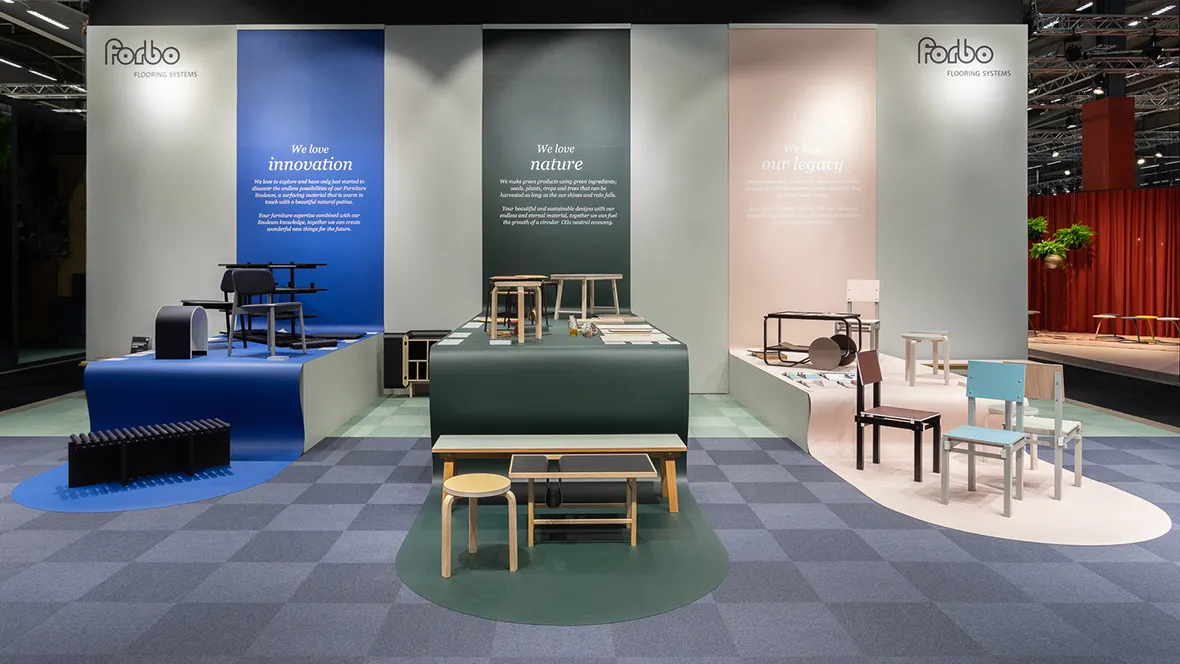
Read here about the latest design trends observed by our designers.
During the Stockholm Furniture Fair 2020 we presented our Furniture linoleum from an unexpected and fresh angle. On three colourful platforms the rich linoleum history as well as our future linoleum visions and dreams were shared with the audience.
Three separate stories together reflecting a mindset of today. Visual narratives based on the power of joined forces. With the valuable input of independent designers, design labels and design institutes making us understand what the future linoleum could look like. The significance of new linoleum developments was made tangible with their prototypes, sparking the imagination of the viewer, creating wonder and generating curiosity.
Looking at the future means also embracing the past, identifying the potentials of design icons and building on communal histories.
Legacy today is celebrated, classics are re-invented, restored, refurbished, re-interpreted, reshaped, recycled and deconstructed
with an unconditional love and respect for their makers.
The story of nature is in our genes, we innovate by nature, we think nature, and create designs that reveal the naturalness of a material. Today designers honor materials by using their specific properties as starting points. We see products with traces of craft and raw textures, material rest streams explored and transformed into something magically new and alluring.
Sharing knowledge, honouring the past and caring for nature are all recurring themes.
But it’s the beauty of a design that ultimately convinces us, providing this vital human touch that makes us feel comfortable.
Let’s celebrate Beauty!
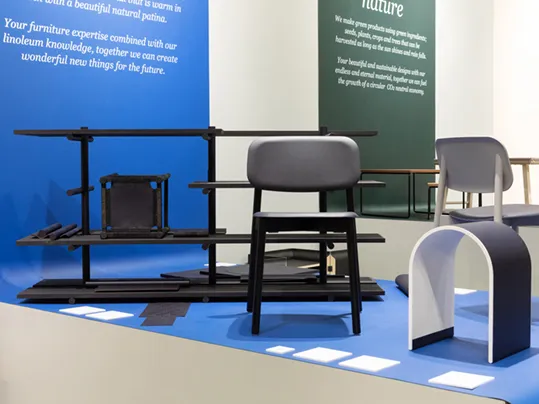
We believe that the expertise of furniture designers/makers and of furniture labels helps us to create wonderful new things for the future.
At the Stockholm Furniture fair a sneak preview of Flexible linoleum beta 471 was presented. This new linoleum development we are currently working on was made tangible with applications on existing high-end furniture designs but also with new experimental shape studies.
Beta 471 is thin linoleum, which stays flexible over time and is easy to bend offering more freedom in 3D forming thus catering the changing needs of the contemporary Furniture industry.
The designers duo Daphna Laurens created a series of prototypes to showcase the possibilities of a new furniture linoleum development. In their trials with the material they explored the technical limits as well as the aesthetic characteristics. By wrapping the sheet material on ‘curvy’ shapes such as wooden rods and metal tubes, the subtle textured surface of the linoleum was emphasized by the reflection of light, thus making the material even livelier. A series of beautiful designs that sparked the imagination of many visitors.

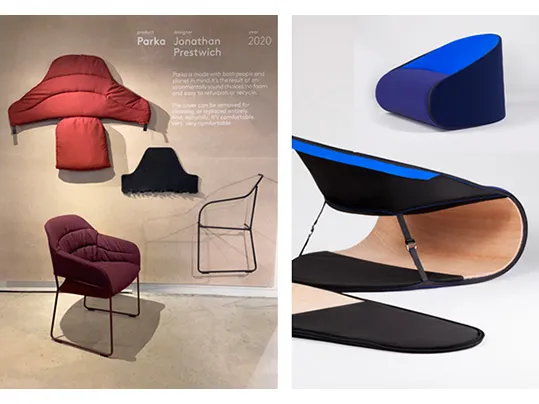
‘Parka’ is a concept by Jonathan Prestwich for the furniture label Arco. A lightweight chair with an easy to refurbish or recycle upholstery that looks like a warm and comfortable padded Parka coat. This agreeable, flexible and sustainable solution was presented during the IMM 2020 in Cologne.
With a future globally mobile generation in mind the young and emerging design duo Panter & Tourron designed ‘Tense’, a series of easy to assemble flat-pack furniture pieces. Allowing one to recreate and rebuild a home anywhere in a few simple steps. The adaptable almost weightless foldable shapes hold their shape solely using tensile strength. A smart and innovative response to the needs of the contemporary explorer who is working, studying, relaxing anywhere and anytime, always on the move.
For the Dutch Design Week 2019 a special project was initiated with Rietvelds’ Military chair as centerpiece. In this collaboration with furniture labels Lensvelt and Rietveld Originals six unique Military chairs were produced each with a different color of Furniture linoleum applied on the horizontal and vertical planes of the chair. In 1923 Gerrit Rietveld designed the Military Chair for the ‘Catholic Military Home’ in Utrecht.
The Military chair was shown in Stockholm for a second time together with other re-interpretations of classic furniture designs using contemporary colours of our current Furniture linoleum colour range. The presentation was a result of the collaborations we initiated with our loyal clients and young furniture labels.
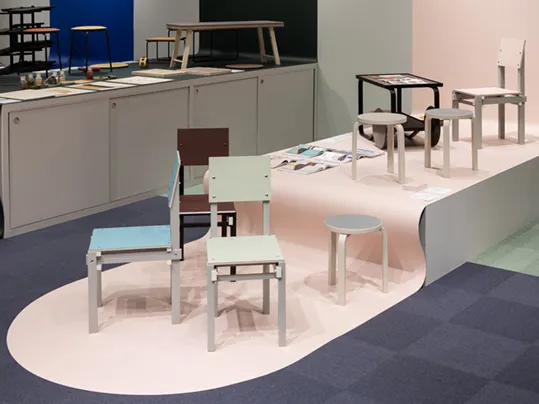
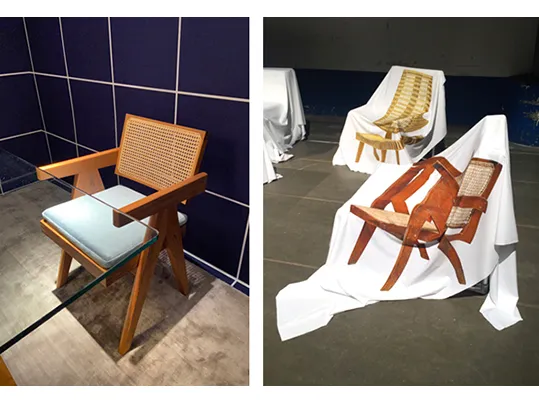
At the IMM furniture fair hommage was paid to Pierre Jeanneret by the Italian furniture company Cassina with the Chandigarh project – the indian city conceived by the Swiss-French architect between 1951 and 1956. For the project Jeannerets’ drawings of chairs and tables from the capitol complex were analysed and used as inspiration for the manufacturing of the presented models.
Home-set, a work from Design Academy graduate Boris Brucher is a furniture ensemble made of scaffolding and digitally printed upholstery fabric. The photographic images depicted on the fabric are of recognizable furniture classics such as the famous Jeannerets’ chair for le Corbusiers’ Chandigarh project. According to Brucher this set of furniture appears as a satire of the modern interior which nowadays usually exists in both physical and digital realities.
On the third island, made with Conifer green Furniture linoleum, the story of the naturalness of linoleum was presented with inspiring new colour experiments. Unique linoleum colour samples showed the influence of the production process on the visual appearance of the material. To make the durability and naturalness of linoleum even more tangible, the colour developments were applied on various contemporary and timeless furniture designs.


‘Cookie Gold’ is a Furniture linoleum with no pigments added. ‘Spanish Red’ is a Furniture linoleum with pure Mineral pigments. Both colours are in development and the material used for the prototypes is from test runs.
Among others, 'Spanish red' was applied on the tabletop of the
CPH deux 220, a table produced by Furniture label Hay and designed by Ronan and Erwan Bouroullec. ‘Cookie Gold’ was used for the seat surface of the Stool 60, a classic design by Alvar Aalto. The ‘Ocher like’ color is defined by the pure colours of the natural raw materials.
In 2019 Christien Meindertsma started with her research into the possibilities of recycling used linoleum and the possible applications. For this project Meindertsma shredded an old linoleum school floor in big chips and in small granulates. Together with the Forbo pilot factory she explored the potential of the used linoleum material.
One of the experiments was to test whether the material can be used as a thin layer pressed on linen canvas. This research was presented in a prototype for a lightweight collapsible seat shaped like a linen painters canvas. The seat is a research model to test the materials rigidness when it is being calandered as a thin layer on top of strong canvas, instead of on top of the usually used flexible jute.
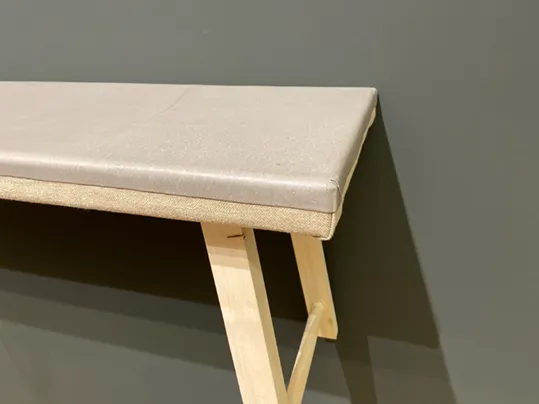
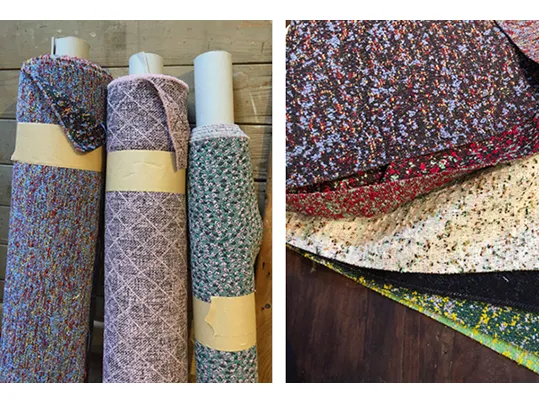
Today designers and artisans focus on materiality and honor materials by using their specific properties as starting points. We see products with traces of craft and raw textures, executed in muted colours. Presented in an earthy backdrop with interior landscapes reflecting the outside. Simple and beautiful designs that are straight forward and romantic, authentic and solid, no nonsense and at the same time luxurious.
A nice illustration of this current trend is the range of upholstery fabrics ‘Ria 741’. Sensuous textiles with an inviting rough texture yet extremely soft surfaces. Inspired on ‘Pointillism’ painting techniques and designed by Raf Simons for Kvadrat.